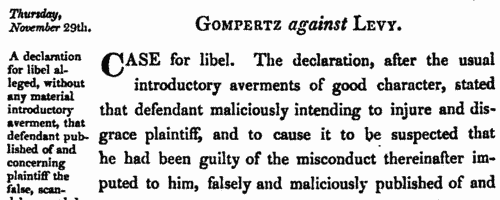Our indexes include entries for the spelling hill. In the period you have requested, we have the following 5,236 records (displaying 2,711 to 2,720):
Dissolutions of Partnerships
(1839)
Trade partnerships dissolved, or the removal of one partner from a partnership of several traders, in England and Wales
| Sample scan, click to enlarge

|
Dividends of bankrupts' estates
(1839)
Dividends from moneys raised from bankrupts' estates in England and Wales | Sample scan, click to enlarge

|
European Residents in Canton
(1839)
The Anglo-Chinese Kalendar, printed in Canton in the 19th year of the reign of Emperor Taou-Kwang, lists European merchants, residents and members of societies, as well as including a brief chronicle of events for the year. English | Sample scan, click to enlarge

|
Insolvents
(1839)
Insolvency notices for England and Wales: insolvency often caused people to restart their lives elsewhere, so these are an important source for lost links | Sample scan, click to enlarge

|
Insolvents
(1839)
Insolvency notices for England and Wales: insolvency often caused people to restart their lives elsewhere, so these are an important source for lost links | Sample scan, click to enlarge

|
London criminals and witnesses
(1839)
Minutes of the evidence presented at the Central Criminal Court were recorded in shorthand by Henry Buckler. This volume covers the whole proceedings of the Queen's Commission of the Peace, Oyer and Terminer, and Gaol Delivery, for the City of London, and Gaol Delivery for the county of Middlesex and those parts of the counties of Essex, Kent and Surrey lying within the jurisdiction of the Central Criminal Court, for the 7th to 12th sessions, from May to October 1839. The index covers both the accused and the witnesses (including police constables &c.) summoned to give evidence. The accused's name is given an asterisk if previously in custody; and a dagger if a 'known associate of bad characters'. Each entry usually concludes with the age of the accused, the verdict, and, where guilty, the sentence. | Sample scan, click to enlarge

|
Mathematics students at Cambridge University
(1839)
Tripos lists or examination results for the year, arranged by class (Wranglers, Senior Optimes and Junior Optimes), and within each class in order of score in the examination (the names of candidates with equal scores are bracketed together, with the word 'AEq.'). Each student's surname and college is given: this list was printed in 1890, and was annotated with asterisks to show which students had subsequently become fellows of the university; and with footnotes showing those who became headmasters, &c., elsewhere. Winners of Dr Smith's Mathematical Prizes are marked (1) senior, (2) for junior. The Greek letter alpha is affixed to the names of those students who had gained first class results in the Classical Tripos; beta to those entered in the second class; and gamma to those entered in the third class. These lists are particularly useful in identifying for an individual the fellow-students who will have attended lectures with him; and, where from the college, are likely to have been even more closely associated by having been under the same supervisor. (The sample scan is from the start of the Mathematics Tripos list for 1770) | Sample scan, click to enlarge

|
North Tipperary Jurors: Nenagh: July 1839
(1839)
'Names of the petty jury to try between our Sovereign Lady (Queen Victoria) and the Traversers, at a General Assizes and Gaol Delivery, held at Nenagh, in and for the North Riding of the County of Tipperary, on Wednesday the 24th day of July 1839'. The list gives: full name; parish or place of abode; and occupation (such as esquire, gentleman, or merchant). | Sample scan, click to enlarge

|
North Tipperary Jurors: Nenagh: March 1839
(1839)
'Names of the petty jury to try between our Sovereign Lady (Queen Victoria) and the Traversers, at a General Assizes and Gaol Delivery, held at Nenagh, in and for the North Riding of the County of Tipperary, on Wednesday the 20th day of March 1839'. The list gives: full name; parish or place of abode; and occupation (such as esquire, gentleman, or merchant). | Sample scan, click to enlarge

|
People mentioned in cases heard in the Court of Queen's Bench
(1839)
John Leycester Adolphus of the Inner Temple and Thomas Flower Ellis of the Middle Temple, barristers-at-law, prepared reports of cases argued and determined in the Court of Queen's Bench. This is the volume for Hilary term and vacation of the 2nd year of queen Victoria, but also including the long and important case Stockdale against Hansard (as to whether the printing of parliamentary papers was subject to the laws of libel). They normally set out for each case a narrative of the evidence presented to the court; then the arguments of the counsel for both sides, usually with reference to legal precedents; and then the judgment, in detail. The evidence in these cases is often extensive, and of historical and genealogical interest; the incidents leading up to the suits usually took place in the preceding ten years or so, but in some cases the narrative stretches back much further, even to the 12th century. This is the index to the stray names, not of the principal parties or the lawyers involved, mentioned in the circumstances of the cases. | Sample scan, click to enlarge

|
Research your ancestry, family history, genealogy and one-name study by direct access to original records and archives indexed by surname.











